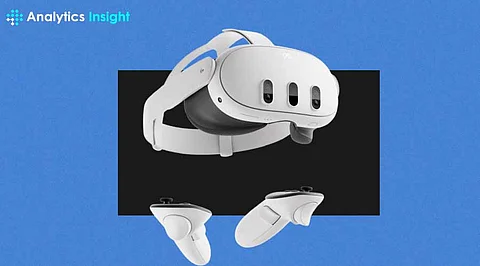

Mixed and virtual reality have been delivering promises for decades to alter the world of entertainment, gaming, and even daily productivity. Yet, it was only with the success of the Meta Quest 3 that mixed reality truly felt seamless, accessible, and immersive in this day and age. The application was launched in October 2023 and is built on the Quest 2's successes, including quite a bit of new hardware and software. What amounts to a game-changer or just another mediocre upgrade? This article digs deep into its features and performance, as well as its overall impact on mixed reality.
The immediate change that many will notice about the Meta Quest 3 is its refined design. Instead of feeling really bulky like the Quest 2 did, the Quest 3 is 40 percent trimmer, call it trim and properly so. That is a lot more comfortable for extended sessions. Pancake lenses, not fresnel lenses, now make up the system. This improves clarity but also helps reduce size.
The head strap has been redesigned as well with the weight distribution more balanced, something which makes a big difference in comfort levels, especially for users wearing the headset for longer durations. The enhanced grip imparts a wispy feeling of integrity, allowing the mesh structure to come into play without affecting any degree of ventilation. Meta considered feedback from users and put in the work on ergonomics for an even more enjoyable experience.
Screen technology is by far the biggest improvement to Quest 3. With each eye having a resolution of 2064 x 2208 pixels, the visual acuity is significantly higher than the Quest 2's 1832 x 1920 pixels. The headset also has 72Hz, 90Hz, and 120Hz refresh rates, which are smooth and immersive in various applications.
The new lenses also help provide a wider field of view, which makes virtual worlds feel more real. Colours are richer, and the feared screen-door effect is all but gone. These improvements make the Quest 3 an attractive option not only for gaming but also for productivity and social VR applications.
Under the hood, the Meta Quest 3 is driven by the Qualcomm Snapdragon XR2 Gen 2 processor coupled with 8GB of RAM. Together, they provide great increases in processing power, enabling quicker load times, improved graphical integrity, and a smoother overall experience. More realistic physics and AI-based interactions within virtual worlds are also made possible with the added power, enabling a more dynamic and interactive gaming experience.
Users have reported that the system performs incredibly smoothly, even under demanding applications like mixed-reality gaming, when real-world spaces are seamlessly blended with digital layers. The enhanced GPU performance is such that it allows developers to build more detailed and interactive worlds.
The standout characteristic of the Quest 3 is its high-end mixed reality capability. With dual 4MP RGB cameras and a depth sensor, the headset provides a full-colour passthrough, enabling users to view their actual environment in high definition while they engage with virtual objects.
This feature is a game-changer, as it opens up possibilities for productivity, design, and social interactions beyond traditional VR applications. Whether it's designing 3D models in your physical space or using AR-enhanced workspaces, the Quest 3 is one of the most versatile headsets available.
Aside from hardware, how good a VR headset is depends on the quality of its software platform, and the Quest 3 delivers. It is completely backward compatible with Quest 2 content, providing users with an enormous library of content right out of the box. Developers have also started optimising their games to make the most of the Quest 3's improved processing power, which results in improved visual fidelity and performance.
Meta has also enhanced the user interface with the experience made easier to navigate. The new menu system and hand-tracking features further simplify the process, allowing people to easily interact with virtual objects naturally without the need for controllers in certain situations.
One of the Quest 3's few downsides is its battery life. It averages 2.2 hours per charge, which is in line with expectations for standalone VR headsets but may need frequent recharging for extended use. That said, considering the additional power and better visuals, the compromise is justifiable.
The Meta Quest 3 comes in two storage variants in India:
128GB Variant: Rs 57,990 on Amazon India and Rs 58,990 on Flipkart, both offering a small discount from the initial price.
512GB Variant: Rs 49,999 on Design Info, a deep discount from its original listing price.
Although it costs more than standard gaming consoles, the Quest 3 provides a whole different experience that is worth its price, especially for those who are heavily into VR and AR experiences.
For those undecided between the Quest 3 and the Meta Quest Pro, it comes down to use. The Quest Pro offers eye-tracking and a higher-end design but at almost double the cost (₹92,000). In contrast, the Quest 3 offers better resolution, and an increased refresh rate, and is much more affordable for mass users. Unless you particularly require the additional enterprise-oriented features of the Quest Pro, the Quest 3 is the better balanced and value-for-money option.
The Meta Quest 3 is not a mere incremental update—it's a major step forward in mixed reality. With better graphics, a new and more powerful processor, and more sophisticated MR features, it produces an experience that feels next-gen. Although battery life and cost are issues for some, overall performance, comfort, and software support make it the most capable standalone VR headset available.
For gamers, content creators, and professionals who want a glimpse of the future, the Quest 3 is worthwhile to invest in.
